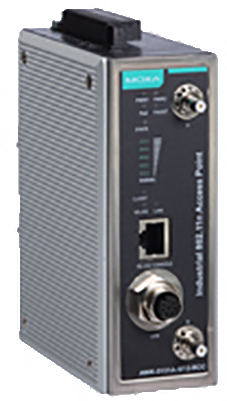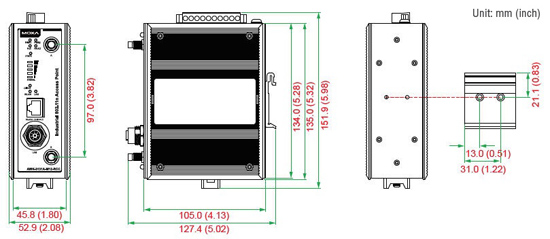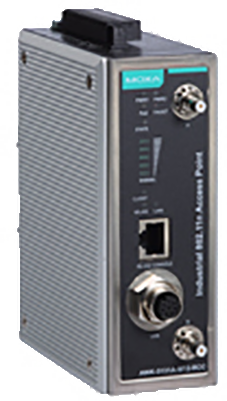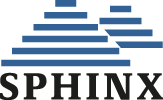MOXA AWK-3131A-M12-RCC Series
Industrial IEEE 802.11a/b/g/n wireless AP/client




- Designed specifically for rail carriage-to-carriage communication
- IEEE 802.11a/b/g/n compliant
- Up to 300 Mbps data rate
- M12 anti-vibration connectors
- MIMO technology increases data throughput and range
- Complies with a portion of EN 50155 specifications
- -40 to 75°C operating temperature range (T models)
- Supports Auto Carriage-to-Carriage connection function
The AWK-3131A-M12-RCC series industrial 802.11n wireless AP/client is an ideal wireless solution for applications such as onboard passenger infotainment systems and inter-carriage wireless backbone networks. The AWK-3131A-M12-RCC series provides a faster data rate than the 802.11g model and is ideal for a great variety of wireless configurations and applications. The auto carriage connection (ACC) feature provides simple deployment and increases the reliability of wireless carriage backbone networks. The AWK- 3131A-M12-RCC series is also optimized for passenger Wi-Fi services and complies with a portion of EN 50155 specifications, covering operating temperature, power input voltage, surge, ESD, and vibration, making the products suitable for a variety of industrial applications. The AWK-3131A-M12-RCC series can also be powered via PoE for easier deployment.
Improved Higher Data Rate and Bandwidth
- High-speed wireless connectivity with up to 300 Mbps data rate
- MIMO technology to improve the capability of transmitting andreceiving multiple data streams
- Increased channel width with channel bonding technology
Specifications for Industrial-Grade Applications
- Industrial-grade QoS and VLAN for efficient data traffic management
- Integrated DI/DO for on-site monitoring and warnings
- Signal strength LEDs for easy deployment and antenna alignment

Specification
| • WLAN Interface | |
| Standards | IEEE 802.11a/b/g/n for Wireless LAN IEEE 802.11i for Wireless Security IEEE 802.3 for 10BaseT IEEE 802.3u for 100BaseT(X) IEEE 802.3ab for 1000BaseT IEEE 802.3af for Power-over-Ethernet IEEE 802.1Q for VLAN |
| Spread Spectrum and Modulation (typical) | • DSSS with DBPSK, DQPSK, CCK • OFDM with BPSK, QPSK, 16QAM, 64QAM • 802.11b: CCK @ 11/5.5 Mbps, DQPSK @ 2 Mbps, DBPSK @ 1 Mbps • 802.11a/g: 64QAM @ 54/48 Mbps, 16QAM @ 36/24 Mbps, QPSK @ 18/12 Mbps, BPSK @ 9/6 Mbps • 802.11n: 64QAM @ 300 Mbps to BPSK @ 6.5 Mbps (multiple rates supported) |
| Operating Channels (central frequency) | US: 2.412 to 2.462 GHz (11 channels) 5.180 to 5.240 GHz (4 channels) 5.260 to 5.320 GHz (4 channels)* 5.500 to 5.700 GHz (8 channels, excluding 5.600 to 5.640 GHz)* 5.745 to 5.825 GHz (5 channels) EU: 2.412 to 2.472 GHz (13 channels) 5.180 to 5.240 GHz (4 channels) 5.260 to 5.320 GHz (4 channels)* 5.500 to 5.700 GHz (11 channels)* JP: 2.412 to 2.484 GHz (14 channels) 5.180 to 5.240 GHz (4 channels) 5.260 to 5.320 GHz (4 channels)* 5.500 to 5.700 GHz (11 channels)* |
| *DFS (Dynamic Frequency Selection) channel supportIn AP mode, when a radar signal is detected, the device will automatically switch to another channel. However according to regulations, after switching channels, a 60-second availability check period is required before starting the service. | |
| Security | • SSID broadcast enable/disable • Firewall for MAC/IP/Protocol/Port-based filtering • 64-bit and 128-bit WEP encryption, WPA/WPA2-Personal and Enterprise (IEEE 802.1X/RADIUS, TKIP, and AES) |
| Transmission Rates | 802.11b: 1, 2, 5.5, 11 Mbps 802.11a/g: 6, 9, 12, 18, 24, 36, 48, 54 Mbps 802.11n: 6.5 to 300 Mbps (multiple rates supported) |
| TX Transmit Power | 802.11b: • Typ. 26±1.5 dBm @ 1 Mbps • Typ. 26±1.5 dBm @ 2 Mbps • Typ. 26±1.5 dBm @ 5.5 Mbps • Typ. 25±1.5 dBm @ 11 Mbps 802.11g: • Typ. 23±1.5 dBm @ 6 to 24 Mbps • Typ. 21±1.5 dBm @ 36 Mbps • Typ. 19±1.5 dBm @ 48 Mbps • Typ. 18±1.5 dBm @ 54 Mbps 802.11n (2.4 GHz): • Typ. 23±1.5dBm @ MCS0 20 MHz • Typ. 21±1.5dBm @ MCS1 20 MHz • Typ. 21±1.5dBm @ MCS2 20 MHz • Typ. 21±1.5dBm @ MCS3 20 MHz • Typ. 20±1.5dBm @ MCS4 20 MHz • Typ. 19±1.5dBm @ MCS5 20 MHz • Typ. 18±1.5dBm @ MCS6 20 MHz • Typ. 18±1.5dBm @ MCS7 20 MHz • Typ. 23±1.5dBm @ MCS8 20 MHz • Typ. 21±1.5dBm @ MCS9 20 MHz • Typ. 21±1.5dBm @ MCS10 20 MHz • Typ. 21±1.5dBm @ MCS11 20 MHz • Typ. 20±1.5dBm @ MCS12 20 MHz • Typ. 19±1.5dBm @ MCS13 20 MHz • Typ. 18±1.5dBm @ MCS14 20 MHz • Typ. 18±1.5dBm @ MCS15 20 MHz • Typ. 23±1.5dBm @ MCS0 40 MHz • Typ. 20±1.5dBm @ MCS1 40 MHz • Typ. 20±1.5dBm @ MCS2 40 MHz • Typ. 20±1.5dBm @ MCS3 40 MHz • Typ. 19±1.5dBm @ MCS4 40 MHz • Typ. 19±1.5dBm @ MCS5 40 MHz • Typ. 18±1.5dBm @ MCS6 40 MHz • Typ. 17±1.5dBm @ MCS7 40 MHz • Typ. 23±1.5dBm @ MCS8 40 MHz • Typ. 20±1.5dBm @ MCS9 40 MHz • Typ. 20±1.5dBm @ MCS10 40 MHz • Typ. 20±1.5dBm @ MCS11 40 MHz • Typ. 20±1.5dBm @ MCS12 40 MHz • Typ. 19±1.5dBm @ MCS13 40 MHz • Typ. 18±1.5dBm @ MCS14 40 MHz • Typ. 17±1.5dBm @ MCS15 40 MHz 802.11a: • Typ. 23±1.5 dBm @ 6 to 24 Mbps • Typ. 21±1.5 dBm @ 36 Mbps • Typ. 20±1.5 dBm @ 48 Mbps • Typ. 18±.5 dBm @ 54 Mbps 802.11n (5 GHz): • Typ. 23±1.5dBm @ MCS0 20 MHz • Typ. 20±1.5dBm @ MCS1 20 MHz • Typ. 20±1.5dBm @ MCS2 20 MHz • Typ. 20±1.5dBm @ MCS3 20 MHz • Typ. 19±1.5dBm @ MCS4 20 MHz • Typ. 18±1.5dBm @ MCS5 20 MHz • Typ. 18±1.5dBm @ MCS6 20 MHz • Typ. 18±1.5dBm @ MCS7 20 MHz • Typ. 23±1.5dBm @ MCS8 20 MHz • Typ. 20±1.5dBm @ MCS9 20 MHz • Typ. 20±1.5dBm @ MCS10 20 MHz • Typ. 20±1.5dBm @ MCS11 20 MHz • Typ. 19±1.5dBm @ MCS12 20 MHz • Typ. 19±1.5dBm @ MCS13 20 MHz • Typ. 18±1.5dBm @ MCS14 20 MHz • Typ. 18±1.5dBm @ MCS15 20 MHz • Typ. 23±1.5dBm @ MCS0 40 MHz • Typ. 20±1.5dBm @ MCS1 40 MHz • Typ. 20±1.5dBm @ MCS2 40 MHz • Typ. 20±1.5dBm @ MCS3 40 MHz • Typ. 19±1.5dBm @ MCS4 40 MHz • Typ. 18±1.5dBm @ MCS5 40 MHz • Typ. 18±1.5dBm @ MCS6 40 MHz • Typ. 18±1.5dBm @ MCS7 40 MHz • Typ. 23±1.5dBm @ MCS8 40 MHz • Typ. 20±1.5dBm @ MCS9 40 MHz • Typ. 20±1.5dBm @ MCS10 40 MHz • Typ. 20±1.5dBm @ MCS11 40 MHz • Typ. 19±1.5dBm @ MCS12 40 MHz • Typ. 19±1.5dBm @ MCS13 40 MHz • Typ. 18±1.5dBm @ MCS14 40 MHz • Typ. 18±1.5dBm @ MCS15 40 MHz |
| RX Sensitivity | 2.4 GHz 802.11b: • -93 dBm @ 1 Mbps • -93 dBm @ 2 Mbps • -93 dBm @ 5.5 Mbps • -88 dBm @ 11 Mbps 802.11g: • -88 dBm @ 6 Mbps • -86 dBm @ 9 Mbps • -85 dBm @ 12 Mbps • -85 dBm @ 18 Mbps • -85 dBm @ 24 Mbps • -82 dBm @ 36 Mbps • -78 dBm @ 48 Mbps • -74 dBm @ 54 Mbps 802.11n (2.4 GHz): • -89 dBm @ MCS0 20 MHz • -85 dBm @ MCS1 20 MHz • -85 dBm @ MCS2 20 MHz • -82 dBm @ MCS3 20 MHz • -78 dBm @ MCS4 20 MHz • -74 dBm @ MCS5 20 MHz • -72 dBm @ MCS6 20 MHz • -70 dBm @ MCS7 20 MHz • -95 dBm @ MCS8 20 MHz • -90 dBm @ MCS9 20 MHz • -87 dBm @ MCS10 20 MHz • -83 dBm @ MCS11 20 MHz • -80 dBm @ MCS12 20 MHz • -74 dBm @ MCS13 20 MHz • -71 dBm @ MCS14 20 MHz • -69 dBm @ MCS15 20 MHz • -87 dBm @ MCS0 40 MHz • -83 dBm @ MCS1 40 MHz • -83 dBm @ MCS2 40 MHz • -80 dBm @ MCS3 40 MHz • -76 dBm @ MCS4 40 MHz • -73 dBm @ MCS5 40 MHz • -69 dBm @ MCS6 40 MHz • -67 dBm @ MCS7 40 MHz • -93 dBm @ MCS8 40 MHz • -88 dBm @ MCS9 40 MHz • -85 dBm @ MCS10 40 MHz • -82 dBm @ MCS11 40 MHz • -78 dBm @ MCS12 40 MHz • -73 dBm @ MCS13 40 MHz • -69 dBm @ MCS14 40 MHz • -67 dBm @ MCS15 40 MHz 802.11a: • -90 dBm @ 6 Mbps • -88 dBm @ 9 Mbps • -88 dBm @ 12 Mbps • -85 dBm @ 18 Mbps • -81 dBm @ 24 Mbps • -78 dBm @ 36 Mbps • -74 dBm @ 48 Mbps • -74 dBm @ 54 Mbps 802.11n (5 GHz): • -88 dBm @ MCS0 20 MHz • -85 dBm @ MCS1 20 MHz • -82 dBm @ MCS2 20 MHz • -79 dBm @ MCS3 20 MHz • -76 dBm @ MCS4 20 MHz • -71 dBm @ MCS5 20 MHz • -70 dBm @ MCS6 20 MHz • -69 dBm @ MCS7 20 MHz • -95 dBm @ MCS8 20 MHz • -91 dBm @ MCS9 20 MHz • -87 dBm @ MCS10 20 MHz • -80 dBm @ MCS11 20 MHz • -78 dBm @ MCS12 20 MHz • -74 dBm @ MCS13 20 MHz • -72 dBm @ MCS14 20 MHz • -71 dBm @ MCS15 20 MHz • -84 dBm @ MCS0 40 MHz • -81 dBm @ MCS1 40 MHz • -77 dBm @ MCS2 40 MHz • -75 dBm @ MCS3 40 MHz • -71 dBm @ MCS4 40 MHz • -67 dBm @ MCS5 40 MHz • -64 dBm @ MCS6 40 MHz • -63 dBm @ MCS7 40 MHz • -90 dBm @ MCS8 40 MHz • -85 dBm @ MCS9 40 MHz • -82 dBm @ MCS10 40 MHz • -81 dBm @ MCS11 40 MHz • -77 dBm @ MCS12 40 MHz • -73 dBm @ MCS13 40 MHz • -71 dBm @ MCS14 40 MHz • -68 dBm @ MCS15 40 MHz |
| • Protocol Support | |
| General Protocols | Proxy ARP, DNS, HTTP, HTTPS, IP, ICMP, SNTP, TCP, UDP, RADIUS, SNMP, DHCP |
| AP-only Protocols | ARP, BOOTP, DHCP |
| • Interface | |
| M12 Ports | 1, M12 A-coded 8-pin female connector, 10/100/1000BaseT(X) auto negotiation speed, F/H duplex mode, auto MDI/MDI-X connection |
| Console Port | RS-232 (RJ45-type) |
| Reset | Present |
| LED Indicators | PWR1, PWR2, PoE, FAULT, STATE, signal strength, Client, WLAN, LAN |
| Alarm Contact (digital output) | 1 relay output with current carrying capacity of 1 A @ 24 VDC |
| Digital Inputs | 2 electrically isolated inputs • +13 to +30 V for state “1” • +3 to -30 V for state “0” • Max. input current: 8 mA |
| Connector for External Antennas | QMA (female) |
| • Physical Characteristics | |
| Housing | Metal, IP30 protection |
| Weight | 850 g (1.87 lb) |
| Dimensions | 52.9 x 151.9 x 127.4 mm (2.08 x 5.98 x 5.02 in) |
| Installation | DIN-rail mounting (standard), wall mounting (optional) |
| • Environmental Limits | |
| Operating Temperature | Standard Models: -25 to 60°C (-13 to 140°F)Wide Temp. Models: -40 to 75°C (-40 to 167°F) |
| Storage Temperature | -40 to 85°C (-40 to 185°F) |
| Ambient Relative Humidity | 5% to 95% (non-condensing) |
| • Power Requirements | |
| Input Voltage | 12 to 48 VDC, redundant dual DC power inputs or 48 VDC Power-over-Ethernet (IEEE 802.3af compliant) |
| Input Current | Maximum 8.03 W (12 V / 0.67 A to 48 V / 0.17 A), 25°C |
| Connector | 10-pin removable terminal block |
| Reverse Polarity Protection | Present |
| • Standards and Certifications | |
| Safety | EN 60950-1(LVD), UL 60950-1, IEC 60950-1(CB) |
| EMC | EN 55032/24 |
| EMI | CISPR 32, FCC Part 15B Class B |
| EMS | IEC 61000-4-2 ESD: Contact: 8 kV; Air: 15 kV IEC 61000-4-3 RS: 80 MHz to 1 GHz: 20 V/m IEC 61000-4-4 EFT: Power: 2 kV; Signal: 2 kV IEC 61000-4-5 Surge: Power: 2 kV; Signal: 2 kV IEC 61000-4-6 CS: 10 V IEC 61000-4-8 |
| Radio | EU: EN 300 328, EN 301 893 US: FCC ID SLE-WAPN008 JP: TELEC Singapore: IDA |
| Rail Traffic | EN 50155*, EN 50121-4, EN 45545-2 |
| *Complies with a portion of EN 50155 specifications. | |
| • MTBF (mean time between failures) | |
| Time | 742,649 hrs |
| Standard | Telcordia SR332 |
Available Models
| Model No. | Description |
|---|---|
| AWK-3131A-M12-RCC-EU | Industrial IEEE 802.11a/b/g/n wireless AP/client, 1 M12 Gigabit LAN port, QMA antenna interface, -25 to 60°C operating temperature, Europe band |
| AWK-3131A-M12-RCC-EU-T | Industrial IEEE 802.11a/b/g/n wireless AP/client, 1 M12 Gigabit LAN port, QMA antenna interface, -40 to 75°C operating temperature, Europe band |
| AWK-3131A-M12-RCC-EU-CT | Industrial IEEE 802.11a/b/g/n wireless AP/client, conformal coating, 1 M12 Gigabit LAN port, QMA antenna interface, -25 to 60°C operating temperature, Europe band |
| AWK-3131A-M12-RCC-EU-CT-T | Industrial IEEE 802.11a/b/g/n wireless AP/client, conformal coating, 1 M12 Gigabit LAN port, QMA antenna interface, -40 to 75°C operating temperature, Europe band |
Optional Accessories
| Model No. | Description |
|---|---|
| WK-51-01 | Wall-mounting kit, 51mm wide |
 Clients qui ont dájà consulté cet article ont également vu
Clients qui ont dájà consulté cet article ont également vu













 Les caractéristiques
Les caractéristiques Présentation
Présentation Plus d'information
Plus d'information



 Les caractéristiques
Les caractéristiques Présentation
Présentation PDF
PDF